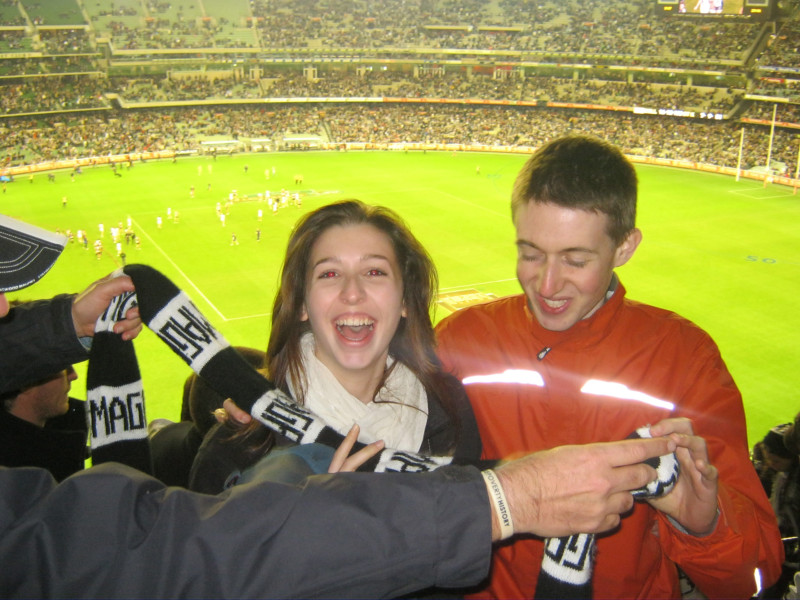Australian Football: Get the Most Out Your First Game

There are no ifs, ands, or buts about it. When you are in Australia, you must go to a footy game. I first fell in love with Australian rules football (also known as Australian football) when I was 10 and visiting family in Melbourne. That first encounter with this country’s national pastime set me on the path to becoming a life-long footy fan.
Since that first game, I’ve learned a few things about what it means to live and breathe this sport. Here are some tips and tricks I’ve picked up along the way that will help you get the most out of your first footy experience.
Australian Football: Get the Most Out Your First Game
The Game
Is it like soccer? Is it like American football? Rugby? The answer is all three, and then some. I like to think of this sport as showing what would happen if you gave a football to a group of school children and told them to have at it. There’s the ball passing and field play of soccer, the scrums of rugby, and the contact of American football — but with zero padding.
Be prepared to keep your eye on the ball as it moves up and down the field for four half-hour quarters, because play is rarely suspended. Everything is fast-paced, with constant turnovers and fights for possession — there’s never a dull moment. Each team consists of 18 players with reserves, and most players serve as defence and offence over the course of the game.
The Lingo
Like any sport, footy has its own special vocabulary, and when I’m at a footy game, I try to do as the Australians do. Here are some must-know terms that I use to fit right in:
Barrack/Barracker: To cheer for a team/One who supports a team. Use this one wisely. I learned the embarrassing way that ‘root’ means something entirely different here. The typical exchange goes something like: “Who do you barrack for?”; “I barrack for [insert team here].”
Floggers: This is one of my favourite things about going to a game here — the fans are really into showing their team pride. But I am most impressed by the true, die-hard fans who sit behind the goal posts with giant poms in their team colours. And by giant, I mean person-sized. Floggers are waved around behind the goal posts when a player is kicking as a way to distract them or celebrate a goal.
Flying Screamers: Also known as the single most spectacular sports move you can witness, based purely on the fact that most are so absurd I sometimes can’t figure out how it happened. A screamer is when a player leaps high into the air to catch a ball, usually climbing over or launching himself off of another player in the process.
Handball: Using the fist to punt a ball to another player. Throwing is not allowed in footy, and considering that the ball is shaped like a football, this seems like a pretty impractical way to move it around. But the players make it work, and this move is a very distinctive feature of Aussie rules football.
Mark: When a player gets a clean catch from a kick that travels more than 10 meters. The receiving player can either take a free kick or immediately play on. It is another one of footy’s most distinctive features, and a team’s ability to mark the ball can make or break their game.
Point vs. Goal: One point is awarded when the ball is kicked through the short, exterior posts. Six points are awarded when the ball is kicked through the tall, interior posts, and it’s known as a goal.
The Teams
The game started back in the 1850s as a way for cricketers to stay fit during the offseason, and the first game of what we know as ‘footy’ was played in Melbourne in 1859. The league has gone through a lot of changes since then, and has expanded out into five of Australia’s seven states. There are currently 18 footy teams, but I think the best place to catch a game is Melbourne, which hosts 10 teams and is therefore a city full of avid footy fans. Unlike most other sports, each team is technically a football club with a mascot used as a nickname for each team. So you’ll hear them referred to by the city more often than the mascot (e.g. Collingwood instead of the Magpies).
Most of these teams have been around for years, and that means loyalties and rivalries are intense. But this kind of enthusiasm doesn’t come without controversies. From what I understand, footy has been plagued by issues of racism and classism, and this usually manifests itself in the way some fans react to other teams. Just a warning, you will hear trash talk and see some shoving during a game, but don’t let this scare you off. All of the teams I’ve seen play have exhibited good sportsmanship as a whole, and the same goes for their fans.
The Experience
The game itself is great, but for me the real cherry on top is the experience of sitting in a stadium packed full of footy fans, wearing my team colours, and cheering as loud as I can. Most stadiums are three-tiered, and there is really no such thing as a bad view in a footy stadium. Try to grab a seat along the side if you can, or just off-centre of the goal posts. If you’re looking for the equivalent of a ball park hotdog, I’m told that meat pies are traditional footy food, and most teams have an official beer sponsor, so you can toast your team and enjoy a cold one at the same time. But really, I think the best way to get the most out of your first experience is to just arrive ready to have a good time. The game, the teams, and the fans will do the rest. It’s an easy sport to like.

Top photo by Unsplash.









Thank you so much Rachael!! I’m in Australia now and have been very confused by this. I appreciate the guidance.